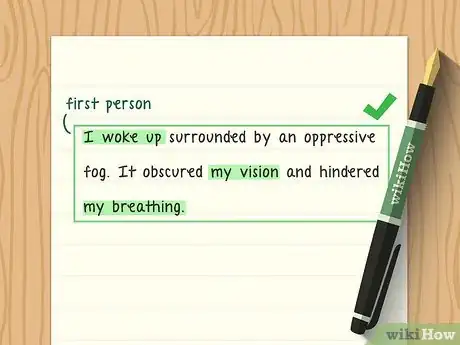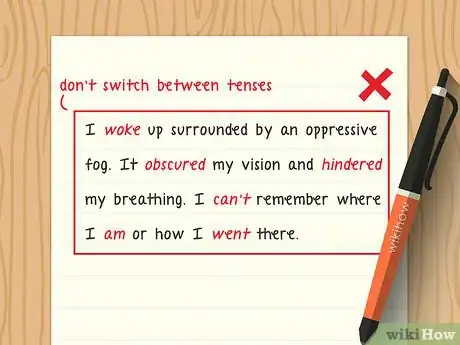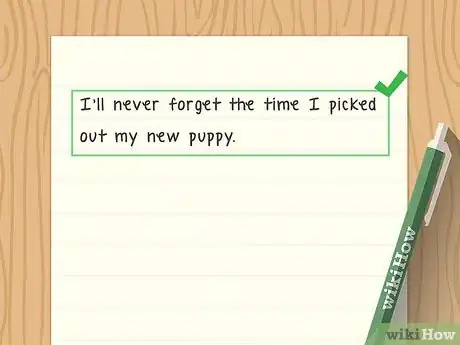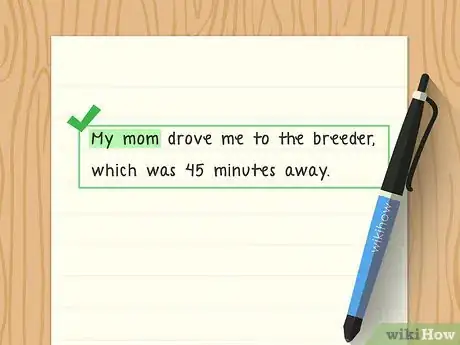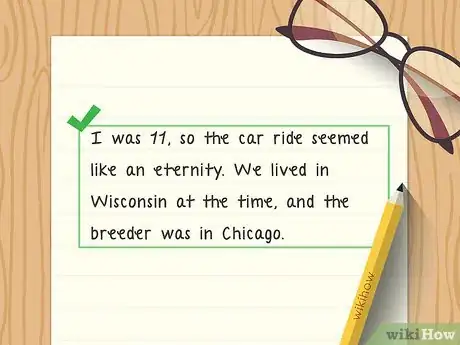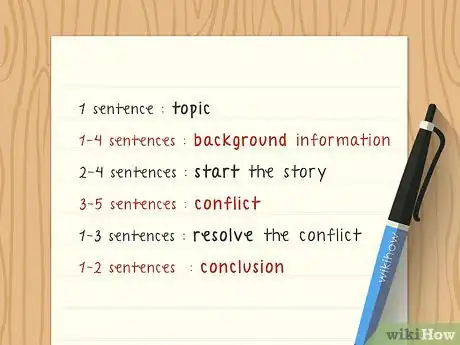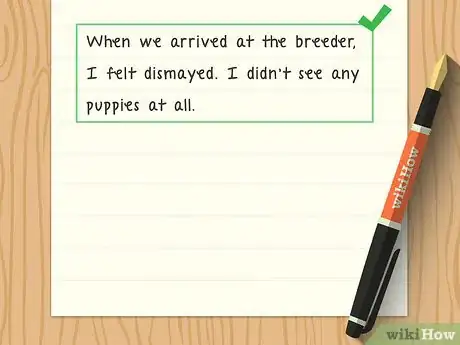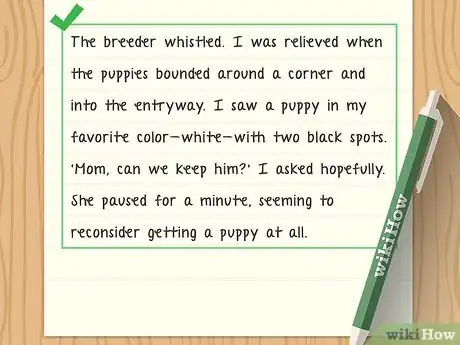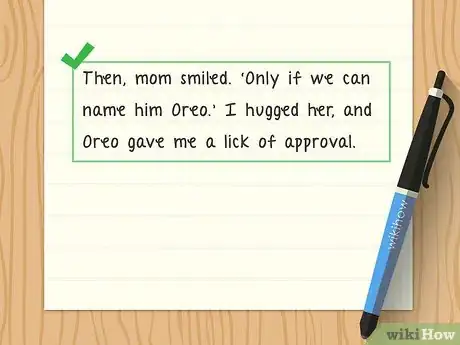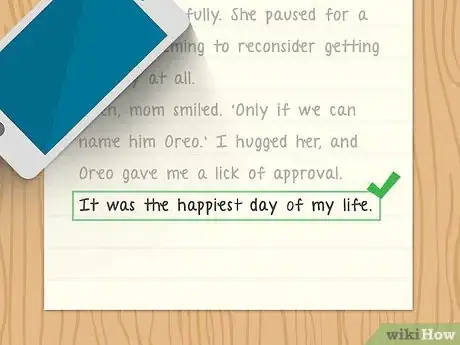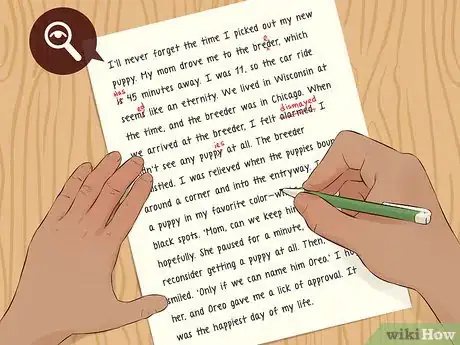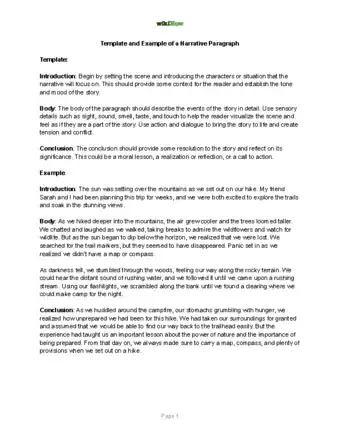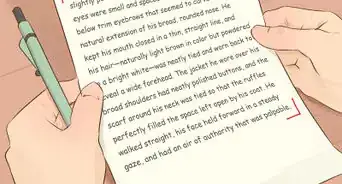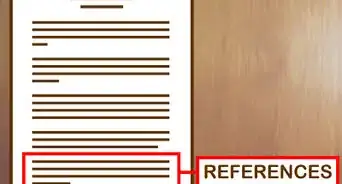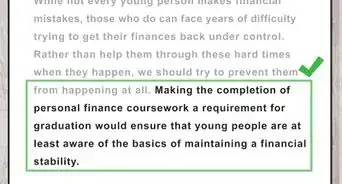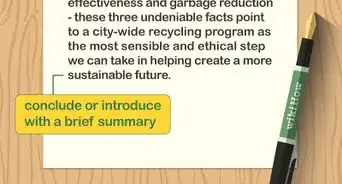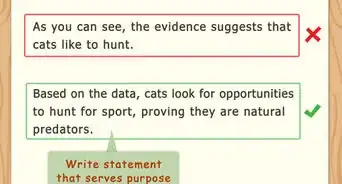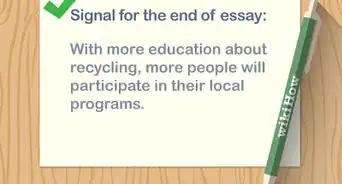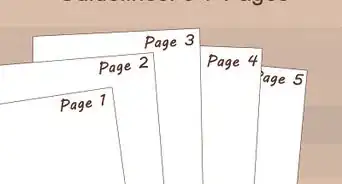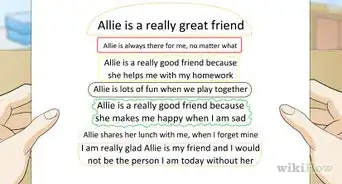This article was co-authored by Grant Faulkner, MA. Grant Faulkner is the Executive Director of National Novel Writing Month (NaNoWriMo) and the co-founder of 100 Word Story, a literary magazine. Grant has published two books on writing and has been published in The New York Times and Writer’s Digest. He co-hosts Write-minded, a weekly podcast on writing and publishing, and has a M.A. in Creative Writing from San Francisco State University.
There are 9 references cited in this article, which can be found at the bottom of the page.
wikiHow marks an article as reader-approved once it receives enough positive feedback. In this case, several readers have written to tell us that this article was helpful to them, earning it our reader-approved status.
This article has been viewed 231,259 times.
A narrative paragraph tells a story, either real or fictional, by introducing a topic, giving more details, and then ending with a reflection or transition to another paragraph. Being able to properly write a narrative paragraph is an essential skill for anyone who wants to write or tell stories, from authors to journalists to advertisers and beyond. Learning the essential elements (an introduction, necessary details, and a conclusion) and how to put them together concisely will enable you to craft brief but complete stories for any audience. Plus, you'll become a better, more confident writer, too!
Steps
Introducing Your Story
-
1Plan to tell your narrative from the first or third person perspective. Use "I," "he," "she," "it," or "they" as the subject to tell your story. While narrative paragraphs are most often told from the first person perspective—relating a story that happened to you—they can also be told from a third person perspective.[1]
- You could relate something that happened to someone else, even a fictional person.
-
2Use a consistent tense. Refer to the prompt or guidelines for the assignment, if applicable, to determine which tense you should use. If there are none, you can choose either past or present tense. Just be sure to use 1 tense consistently throughout the entire paragraph, and avoid switching between tenses.[2]
- The exception would be if you were switching between the current discussion of the story’s meaning (in present tense) and the narrative of the story’s events (past tense).
Advertisement -
3Create an engaging topic sentence. Draw the reader into your narrative paragraph by creating excitement or suspense with your opening sentence. This sentence should introduce the purpose of the paragraph—the story—and make the reader want to read further.[3]
- A good first-person topic sentence might be, “I’ll never forget the time I picked out my new puppy.” If you were using third person, the same topic sentence would be written, “He would never forget the time he picked out his new puppy.”
-
4Present any major characters involved in the story. Introduce any people who will play an important role in the story so the reader understands who is a part of the narrative. You don’t need to introduce every character you will talk about, but it’s helpful to introduce people who advance the action.[4]
- For the first-person example about picking out a new puppy, you might continue, “My mom drove me to the breeder, which was 45 minutes away.”
-
5Set the scene of the story. Provide a setting for your story and orient your reader to the time your story happens. This helps them place themselves in the narrator’s shoes and understand their state of mind for the events.
- You might say: “I was 11, so the car ride seemed like an eternity. We lived in Wisconsin at the time, and the breeder was in Chicago.”
- All background information after the topic sentence, such as other characters and where the story takes place, should be approximately 1-4 sentences long.
-
6Plan to write a narrative paragraph of at least 9 sentences. Write 1 topic sentence, 1-4 sentences of background information, 2-4 sentences to start the story, 3-5 sentences to present the conflict, 1-3 sentences to resolve the conflict, and 1-2 sentences to provide a conclusion.
- While the length of your paragraph will vary based on the content, a standard 5-sentence paragraph likely will not provide enough detail to tell a complete narrative.
Providing Narrative Details
-
1Present the story chronologically from its beginning. Start the story by describing the problem or idea that kicks off the action. It could be anything from a telephone call to a desire for some milk. This start to the story should be 1-4 sentences.[5]
- You could say, ”When we arrived at the breeder, I felt dismayed. I didn’t see any puppies at all.”
-
2Relate the central conflict of the story. Add narrative detail to explain what happens next in the story. Over 3-5 sentences, this should rise to a central point of drama or conflict.[6]
- You might continue, ”The breeder whistled. I was relieved when the puppies bounded around a corner and into the entryway. I saw a puppy in my favorite color—white—with two black spots. ‘Mom, can we keep him?’ I asked hopefully. She paused for a minute, seeming to reconsider getting a puppy at all.”
-
3Provide resolution to the story. Detail for the reader how the story ends. In a good story, often this ending will be a surprise twist or simply a happy moment. If there were any special consequences for the narrator, relate those as well.[7]
- You could end, “Then, mom smiled. ‘Only if we can name him Oreo.’ I hugged her, and Oreo gave me a lick of approval.”
- Resolution could be as brief as 1 sentence or as many as 3.
Concluding Your Story and Proofing Your Paragraph
-
1End the story with a conclusion that reflects on the event. Use your conclusion to give an opinion regarding the story. It might give insight into how the event affects the narrator (perhaps you) in the present day or how it affected choices the narrator made since that event. Typically this is 1-2 sentences long.[8]
- Regarding the puppy story, you might say, ”It was the happiest day of my life.”
- The nature of your conclusion will depend greatly on the tone and content of your story as well as the perspective the story is told from.
-
2Proofread your paragraph for spelling and grammar issues. Look over your paragraph to make sure it is readable and doesn’t have typos or grammar mistakes. Print out a hard copy of your paragraph rather than trying to edit it on the computer.[9]
- Reading your story out loud is a great way to listen for grammar problems and other spots that don’t quite flow.
- Don’t rely on spell-check, as it won’t catch everything!
- Once you've finished proofreading, consider asking someone you trust to read over the paragraph again. They can help you find anything you may have missed![10]
-
3Reread your paragraph to make sure the story stands on its own. Give your paragraph a final read to make sure the story makes sense. If someone walked up to you and told you this story, would you need additional information? If so, provide any additional details necessary to comprehend the story easily.[11]
Template and Example of a Narrative Paragraph
Expert Q&A
-
QuestionHow do you start writing a book?
 Grant Faulkner, MAGrant Faulkner is the Executive Director of National Novel Writing Month (NaNoWriMo) and the co-founder of 100 Word Story, a literary magazine. Grant has published two books on writing and has been published in The New York Times and Writer’s Digest. He co-hosts Write-minded, a weekly podcast on writing and publishing, and has a M.A. in Creative Writing from San Francisco State University.
Grant Faulkner, MAGrant Faulkner is the Executive Director of National Novel Writing Month (NaNoWriMo) and the co-founder of 100 Word Story, a literary magazine. Grant has published two books on writing and has been published in The New York Times and Writer’s Digest. He co-hosts Write-minded, a weekly podcast on writing and publishing, and has a M.A. in Creative Writing from San Francisco State University.
Professional Writer There are many different ways to write a book, and I think everybody has their own particular way. For some people, it can be as simple as getting an idea in the shower or when they're driving to work. Whether it's intended or accidental, the stories occur, and then it's really just a decision. Is this story really calling me? Do I really need to write it? That's how a story is really formed. It becomes something that you can't not write.
There are many different ways to write a book, and I think everybody has their own particular way. For some people, it can be as simple as getting an idea in the shower or when they're driving to work. Whether it's intended or accidental, the stories occur, and then it's really just a decision. Is this story really calling me? Do I really need to write it? That's how a story is really formed. It becomes something that you can't not write. -
QuestionHow can I write a narrative essay on the saying "A bird at hand is better than two birds beyond"?
 Community AnswerA narrative is a story. That saying means that it's better to take what you know you can count on (the bird you have right now in your hand) rather than relying on something that may or may not come in the future (a possible two birds later). So you want to tell a story about why this saying is true. Did you or someone you know ever gamble away something you had thinking you could get more of it later, but that turned out not to be the case? There's your story.
Community AnswerA narrative is a story. That saying means that it's better to take what you know you can count on (the bird you have right now in your hand) rather than relying on something that may or may not come in the future (a possible two birds later). So you want to tell a story about why this saying is true. Did you or someone you know ever gamble away something you had thinking you could get more of it later, but that turned out not to be the case? There's your story. -
QuestionHow can I improve in my vocabulary?
 DonaganTop AnswererActively notice the vocabularies of as many other writers and speakers as possible. Look up words you're not familiar with.
DonaganTop AnswererActively notice the vocabularies of as many other writers and speakers as possible. Look up words you're not familiar with.
References
- ↑ https://www.mtsac.edu/writingcenter/dlas/narrative_and_descriptive_paragraphs_dla_09-03-19.pdf
- ↑ https://owl.purdue.edu/owl/general_writing/grammar/verb_tenses/verb_tense_consistency.html
- ↑ https://k12.thoughtfullearning.com/lessonplan/writing-narrative-paragraph
- ↑ http://writingcenter.unc.edu/tips-and-tools/paragraphs/paragraph-development-examples/
- ↑ https://open.lib.umn.edu/writingforsuccess/chapter/10-1-narration/
- ↑ https://open.lib.umn.edu/writingforsuccess/chapter/10-1-narration/
- ↑ https://opentextbc.ca/buildingblocks/chapter/narrative-paragraphs/
- ↑ https://www.mtsac.edu/writingcenter/dlas/narrative_and_descriptive_paragraphs_dla_09-03-19.pdf
- ↑ https://writing.wisc.edu/Handbook/Proofreading.html
- ↑ Grant Faulkner, MA. Professional Writer. Expert Interview. 8 January 2019.
- ↑ https://opentextbc.ca/writingforsuccess/chapter/chapter-12-peer-review-and-final-revisions/
- ↑ https://k12.thoughtfullearning.com/lessonplan/writing-narrative-paragraph
- ↑ Grant Faulkner, MA. Professional Writer. Expert Interview. 8 January 2019.
About This Article
A narrative paragraph tells a chronological story that can either be real or fictional. A good narrative starts with a strong topic sentence that draws the reader in and introduces the tale you’re going to tell. For example, you might start your paragraph with "I'll never forget the day I picked out my new puppy." Once you hook your reader, introduce any major characters involved in the tale. After you set the scene, introduce the main conflict in the story, which you'll want to resolve by the end. For instance, you might write "When we arrived at the breeder's, I was disappointed. There weren't any puppies in sight. But then I heard a whistle and saw a bunch of puppies race around the corner." Your narrative paragraph should be around 9 sentences long. For tips on how to proofread your narrative paragraph, keep reading!
